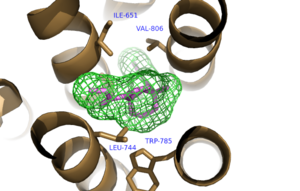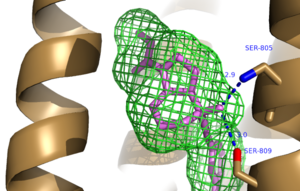User:Daniel Schemenauer/Sandbox 1
From Proteopedia
(Difference between revisions)
| Line 2: | Line 2: | ||
= metabotropic Glutamate Receptor 5 = | = metabotropic Glutamate Receptor 5 = | ||
== Introduction == | == Introduction == | ||
| - | G-coupled protein receptors [https://en.wikipedia.org/wiki/G_protein–coupled_receptor GPCR's] are helical trans-membrane proteins that bind to an extracellular signal and activate a cellular response. The human genome encodes for approximately 750 GPCR's, 350 of which are known to respond to extracellular ligands<ref name="GPCRRep">PMID: 12679517 </ref>. GPCR's are divided into four major classes based on sequence similarity and transduction mechanism: Class A,B,C, and F<ref name="MSGPCR">PMID:23407534</ref>. Metabotropic Glutamate Receptor 5 (<scene name='72/726409/Overview/5'>mGlu<sub>5</sub></scene>) is a class C GPCR that is involved in the G<sub>q</sub> pathway<ref name="CCGPCR">PMID:12782243</ref>. In this pathway, the G-protein disassociates and the alpha subunit activates [https://en.wikipedia.org/wiki/Phospholipase_C Phospholipase C]. Phospholipase C in turn cleaves [https://en.wikipedia.org/wiki/Phosphatidylinositol_4,5-bisphosphate PIP2] to [https://en.wikipedia.org/wiki/Diglyceride DA] and [https://en.wikipedia.org/wiki/Inositol_trisphosphate IP3]. IP3 then binds to calcium channels on the [https://en.wikipedia.org/wiki/Endoplasmic_reticulum Endoplasmic reticulum] creating an increased cellular concentration of calcium. Increased calcium concentrations thus leads to increased neuronal activity<ref name="MSGPCR">PMID:23407534</ref>. | + | G-coupled protein receptors [https://en.wikipedia.org/wiki/G_protein–coupled_receptor (GPCR's)] are helical trans-membrane proteins that bind to an extracellular signal and activate a cellular response. The human genome encodes for approximately 750 GPCR's, 350 of which are known to respond to extracellular ligands<ref name="GPCRRep">PMID: 12679517 </ref>. GPCR's are divided into four major classes based on sequence similarity and transduction mechanism: Class A,B,C, and F<ref name="MSGPCR">PMID:23407534</ref>. Metabotropic Glutamate Receptor 5 (<scene name='72/726409/Overview/5'>mGlu<sub>5</sub></scene>) is a class C GPCR that is involved in the G<sub>q</sub> pathway<ref name="CCGPCR">PMID:12782243</ref>. In this pathway glutamate binds to the extracellular domain of mGlu<sub>5</sub>, the trans-membrane domains undergo a conformational change that activates the coupled [http://proteopedia.org/wiki/index.php/GTP-binding_protein G-protein] on the intracellular side of the membrane. <ref name="Primary">PMID: 25042998 </ref> |
| + | The activated G-protein disassociates and the alpha subunit activates [https://en.wikipedia.org/wiki/Phospholipase_C Phospholipase C]. Phospholipase C in turn cleaves [https://en.wikipedia.org/wiki/Phosphatidylinositol_4,5-bisphosphate PIP2] to [https://en.wikipedia.org/wiki/Diglyceride DA] and [https://en.wikipedia.org/wiki/Inositol_trisphosphate IP3]. IP3 then binds to calcium channels on the [https://en.wikipedia.org/wiki/Endoplasmic_reticulum Endoplasmic reticulum] creating an increased cellular concentration of calcium. Increased calcium concentrations thus leads to increased neuronal activity<ref name="MSGPCR">PMID:23407534</ref>. Due to its involvement in neuronal activity mGlu<sub>5</sub> is highly expressed in neuronal and glial cells in the central nervous system, where glutamate serves as the major neurotransmitter. | ||
| + | |||
== Structure == | == Structure == | ||
=== Overall Stucture === | === Overall Stucture === | ||
Revision as of 17:43, 16 April 2016
| |||||||||||
References
- ↑ Vassilatis DK, Hohmann JG, Zeng H, Li F, Ranchalis JE, Mortrud MT, Brown A, Rodriguez SS, Weller JR, Wright AC, Bergmann JE, Gaitanaris GA. The G protein-coupled receptor repertoires of human and mouse. Proc Natl Acad Sci U S A. 2003 Apr 15;100(8):4903-8. Epub 2003 Apr 4. PMID:12679517 doi:http://dx.doi.org/10.1073/pnas.0230374100
- ↑ 2.0 2.1 Venkatakrishnan AJ, Deupi X, Lebon G, Tate CG, Schertler GF, Babu MM. Molecular signatures of G-protein-coupled receptors. Nature. 2013 Feb 14;494(7436):185-94. doi: 10.1038/nature11896. PMID:23407534 doi:http://dx.doi.org/10.1038/nature11896
- ↑ Pin JP, Galvez T, Prezeau L. Evolution, structure, and activation mechanism of family 3/C G-protein-coupled receptors. Pharmacol Ther. 2003 Jun;98(3):325-54. PMID:12782243
- ↑ 4.0 4.1 4.2 4.3 4.4 4.5 4.6 4.7 4.8 Dore AS, Okrasa K, Patel JC, Serrano-Vega M, Bennett K, Cooke RM, Errey JC, Jazayeri A, Khan S, Tehan B, Weir M, Wiggin GR, Marshall FH. Structure of class C GPCR metabotropic glutamate receptor 5 transmembrane domain. Nature. 2014 Jul 31;511(7511):557-62. doi: 10.1038/nature13396. Epub 2014 Jul 6. PMID:25042998 doi:http://dx.doi.org/10.1038/nature13396
- ↑ Shigemoto R, Nomura S, Ohishi H, Sugihara H, Nakanishi S, Mizuno N. Immunohistochemical localization of a metabotropic glutamate receptor, mGluR5, in the rat brain. Neurosci Lett. 1993 Nov 26;163(1):53-7. PMID:8295733
- ↑ Li G, Jorgensen M, Campbell BM. Metabotropic glutamate receptor 5-negative allosteric modulators for the treatment of psychiatric and neurological disorders (2009-July 2013). Pharm Pat Anal. 2013 Nov;2(6):767-802. doi: 10.4155/ppa.13.58. PMID:24237242 doi:http://dx.doi.org/10.4155/ppa.13.58


